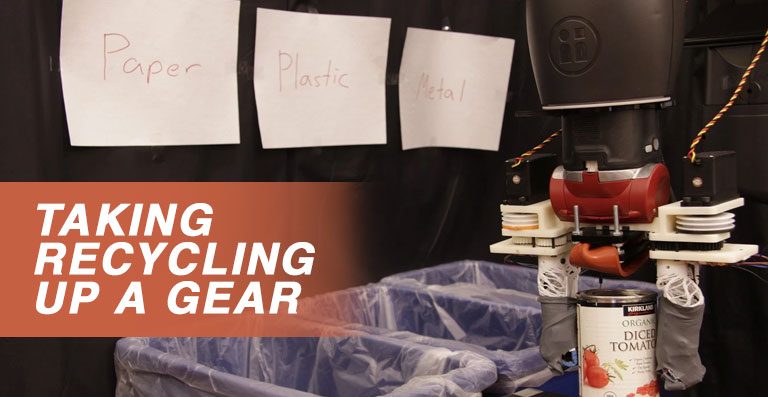How Robots Can Efficiently Sort out Plastic for Recycling
Did you know that trash companies sift through 68 million tons of recycling waste each year? This weight is equivalent to more than 30 million vehicles. This process is undertaken by workers that sort out trash like glass, plastic, and paper that spread out in conveyor belts. Such jobs can often be unsafe and it can get difficult to sort out materials.
For instance, workers in the plastic recycling industry might find it strenuous to remove plastic from the mix of waste that comes in. Keeping this issue in mind, a team of researchers from MIT has designed and developed a highly functional robotic system known as the RoCycle. It can easily detect if an item is plastic, metal or paper.

This system includes a Teflon hand that can detect an item’s stiffness and size with tactile sensors on its fingertips. This system is designed to be compatible with any robotic arm. During tests, they discovered that it was 85% accurate in detecting materials when they were stationary and 63% accurate on a conveyor belt. What’s even more surprising is that it could distinguish between two Starbuck cups that were visually similar but different in material. One was made of plastic and the other of paper.
Daniela Rus, who is one of the researchers from the team, stated that the robot’s skin has multiple sensors that provide haptic feedback to sort out a wide range of objects, from squishy to rigid. She further added that tactile input is of prime importance. This is true especially since computer vision alone cannot determine the type of material. It must have human-like perception such as touch to understand the nature of the material so that it can determine its type.
This project aims to minimize the back-end cost of recycling and reduce the safety risks that come with manual labor. The current recycling machines are not completely automated. They use optical sorters, magnetic sorters, and aluminum sorters. The optical sorters make use of wavelength light to differentiate between materials. The magnetic sorters can separate iron and steel products whereas the aluminum sorters use eddy currents to take out non-magnetic items. This issue of having multiple sorters can be resolved if RoCycle were to be deployed on a wide scale across many recycling industries.
With its built-in sensors, Rocycle can determine the radius of material with 30% accuracy and know the difference between soft and hard materials with 78% accuracy. The robotic arm was also designed to be puncture-resistant. The team is now looking to further enhance Rocycle’s functionality by improving its accuracy in determining materials. They plan to do this by combining tactile data with video data by using the robot’s camera.
If you are in the plastic recycling industry or the robotics industry, then Plastivision is a great platform for you to showcase your product range and network with industry professionals. Book your booth today!
Source:
https://www.weforum.org/agenda/2019/04/robots-that-can-sort-recycling/
Leave a Reply Cancel reply
Recent Posts
- Understanding The Materials That Are Used To Build Plastic Toys
- All You Need To Know About Food-grade Plastics
- A Glance At The Materials That Boost The Performance Of Plastics
- Understanding The Importance Of Exploring New Business Opportunities In The Plastic Industry
- Understanding The Importance Of Investing in R&D For The Plastic Industry
Categories
- 3D Printing
- AIPMA
- Automation
- Automobile Sector
- Bio Plastics
- Environment
- Innovations In Recycling
- Latest Innovations
- Molds & Dies
- News
- Packaging Industry
- Plastic
- Plastic Application
- Plastic Industry
- Plastic Market
- Plastic Myths
- Plastic News From The World
- Plastic Packaging
- Plastic Products
- Plastic Recycling
- Plastic Solar Cells
- Plastic Toys
- Plastic Waste
- Plastic World
- Plastics
- Plastics And Their Applications
- Plastics In Agriculture
- Plastics In Healthcare
- Plastics In Medical Industry
- Plasticulture
- Processing Machinery
- Recycling Machines
- Robotics
- Uncategorized
- Virtual Reality
Archives
- November 2023 (3)
- October 2023 (2)
- September 2023 (3)
- August 2023 (3)
- July 2023 (3)
- June 2023 (3)
- May 2023 (2)
- April 2023 (2)
- March 2023 (2)
- February 2023 (2)
- January 2023 (2)
- December 2022 (3)
- November 2022 (1)
- October 2022 (1)
- September 2022 (2)
- August 2022 (1)
- July 2022 (3)
- May 2022 (3)
- March 2022 (2)
- February 2022 (1)
- January 2022 (1)
- September 2021 (2)
- August 2021 (3)
- July 2021 (4)
- June 2021 (4)
- May 2021 (3)
- April 2021 (2)
- March 2021 (4)
- November 2019 (8)
- October 2019 (8)
- September 2019 (8)
- August 2019 (8)
- July 2019 (8)
- June 2019 (8)
- May 2019 (8)
- April 2019 (8)
- March 2019 (8)
- February 2019 (11)
- January 2019 (8)
- December 2018 (8)
- November 2018 (12)
- October 2018 (12)

